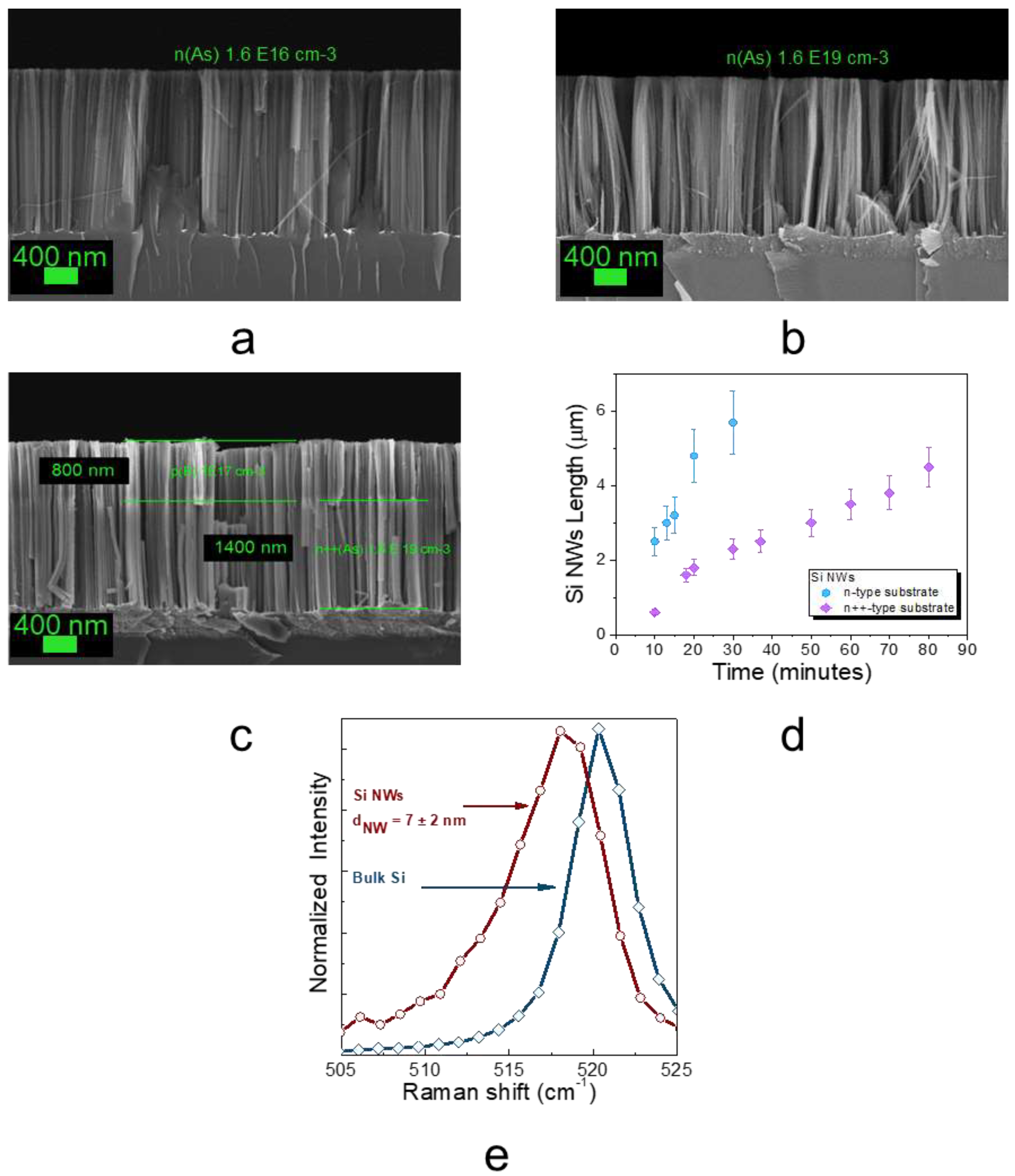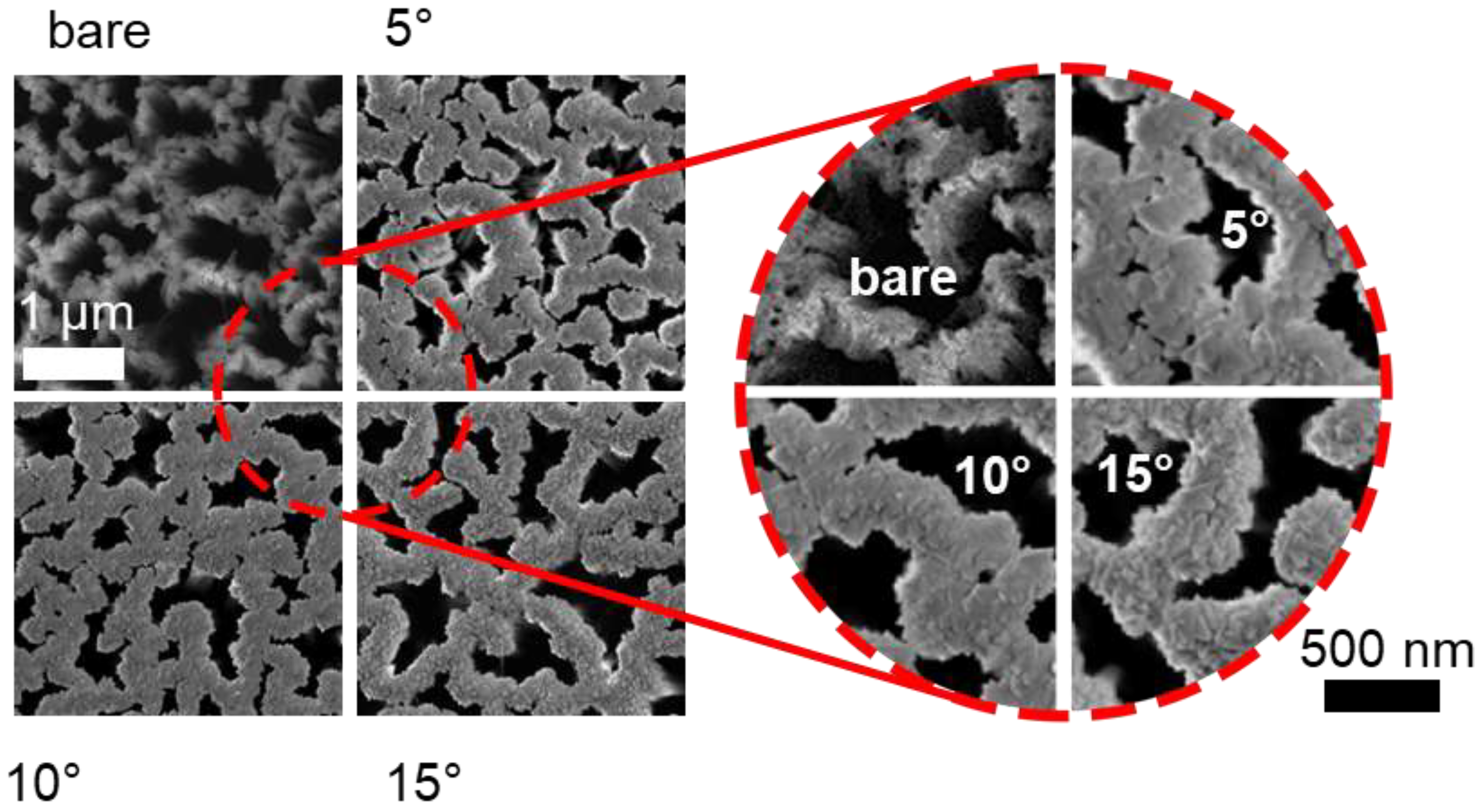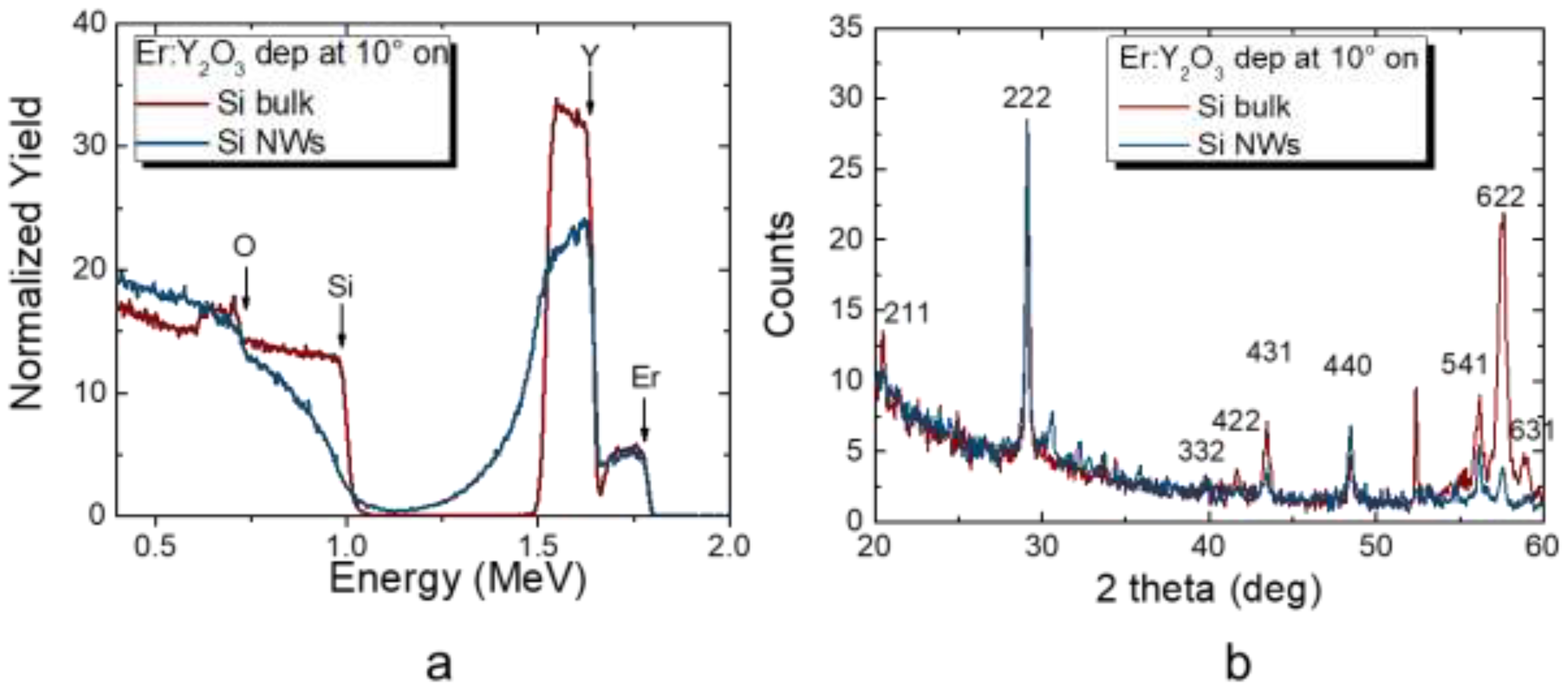Cost-Effective Fabrication of Fractal Silicon Nanowire Arrays
Abstract
1. Introduction
2. Materials and Methods
2.1. Materials and Chemicals
2.2. Thin Film Metal-Assisted Chemical Etching and AZO Deposition
2.3. Characterization Equipment and Measurement Details
3. Results and Discussion
4. Conclusions
Author Contributions
Funding
Data Availability Statement
Acknowledgments
Conflicts of Interest
References
- Cui, Y.; Zhong, Z.; Wang, D.; Wang, W.U.; Lieber, C.M. High performance silicon nanowire field effect transistors. Nano Lett. 2003, 3, 149–152. [Google Scholar] [CrossRef]
- Goldberger, J.; Hochbaum, A.I.; Fan, R.; Yang, P. Silicon vertically integrated nanowire field effect transistors. Nano Lett. 2006, 6, 973–977. [Google Scholar] [CrossRef]
- Feng, W.; Hettiarachchi, R.; Sato, S.; Kakushima, K.; Niwa, M.; Iwai, H.; Yamada, K.; Ohmori, K. Advantages of silicon nanowire metal-oxide-semiconductor field-effect transistors over planar ones in noise properties. Jpn. J. Appl. Phys. 2012, 51, 04DC06. [Google Scholar] [CrossRef]
- Javey, A.; Nam, S.; Friedman, R.S.; Yan, H.; Lieber, C.M. Layer-by-layer assembly of nanowires for three-dimensional, multifunctional electronics. Nano Lett. 2007, 7, 773–777. [Google Scholar] [CrossRef] [PubMed]
- Schmidt, V.; Riel, H.; Senz, S.; Karg, S.; Riess, W.; Gösele, U. Realization of a Silicon Nanowire Vertical Surround-Gate Field-Effect Transistor. Small 2006, 2, 85–88. [Google Scholar] [CrossRef] [PubMed]
- Garnett, E.; Yang, P. Light Trapping in Silicon Nanowire Solar Cells. Nano Lett. 2010, 10, 1082–1087. [Google Scholar] [CrossRef]
- Kelzenberg, M.D.; Boettcher, S.W.; Petykiewicz, J.A.; Turner-Evans, D.B.; Putnam, M.C.; Warren, E.L.; Spurgeon, J.M.; Briggs, R.M.; Lewis, N.S.; Atwater, H.A. Enhanced absorption and carrier collection in Si wire arrays for photovoltaic applications. Nat. Mater. 2010, 9, 239–244. [Google Scholar] [CrossRef] [PubMed]
- Cao, L.; Fan, P.; Vasudev, A.P.; White, J.S.; Yu, Z.; Cai, W.; Schuller, J.A.; Fan, S.; Brongersma, M.L. Semiconductor Nanowire Optical Antenna Solar Absorbers. Nano Lett. 2010, 10, 439–445. [Google Scholar] [CrossRef] [PubMed]
- Zhang, H.; Lei, Y.; Zhu, Q.; Qing, T.; Zhang, T.; Tian, W.; Lange, M.; Jiang, M.; Han, C.; Li, J.; et al. Nanoscale Photovoltaic Responses in 3D Radial Junction Solar Cells Revealed by High Spatial Resolution Laser Excitation Photoelectric Microscopy. ACS Nano 2019, 13, 10359–10365. [Google Scholar] [CrossRef]
- Peters, C.H.; Guichard, A.R.; Hryciw, A.C.; Brongersma, M.L.; McGehee, M.D. Energy transfer in nanowire solar cells with photon-harvesting shells. J. Appl. Phys. 2009, 105, 124509. [Google Scholar] [CrossRef]
- Leonardi, A.A.; Faro, M.J.L.; Irrera, A. CMOS-Compatible and Low-Cost Thin Film MACE Approach for Light-Emitting Si NWs Fabrication. Nanomaterials 2020, 10, 966. [Google Scholar] [CrossRef]
- Faro, M.J.L.; Leonardi, A.A.; Morganti, D.; Fazio, B.; Vasi, C.; Musumeci, P.; Priolo, F.; Irrera, A. Low Cost Fabrication of Si NWs/CuI Heterostructures. Nanomaterials 2018, 8, 569. [Google Scholar] [CrossRef]
- Kalem, S.; Werner, P.; Talalaev, V. Near-IR photoluminescence from Si/Ge nanowire-grown silicon wafers: Effect of HF treatment. Appl. Phys. A Mater. Sci. Process. 2013, 112, 561–567. [Google Scholar] [CrossRef]
- Lo Faro, M.J.; Leonardi, A.A.; Priolo, F.; Fazio, B.; Miritello, M.; Irrera, A. Erbium emission in Er:Y2O3 decorated fractal arrays of silicon nanowires. Sci. Rep. 2020, 10, 12854. [Google Scholar] [CrossRef] [PubMed]
- Khorasaninejad, M.; Saini, S.S. Silicon nanowire optical waveguide (SNOW). Opt. Express 2010, 18, 23442–23457. [Google Scholar] [CrossRef] [PubMed]
- Khorasaninejad, M.; Saini, S.S. Bend waveguides on silicon nanowire optical waveguide (snow). IEEE Photonics J. 2011, 3, 696–702. [Google Scholar] [CrossRef]
- Leonardi, A.A.; Lo Faro, M.J.; Irrera, A. Biosensing platforms based on silicon nanostructures: A critical review. Anal. Chim. Acta 2021, 1160, 338393. [Google Scholar] [CrossRef]
- Leonardi, A.A.; Lo Faro, M.J.; Di Franco, C.; Palazzo, G.; D’Andrea, C.; Morganti, D.; Manoli, K.; Musumeci, P.; Fazio, B.; Lanza, M.; et al. Silicon nanowire luminescent sensor for cardiovascular risk in saliva. J. Mater. Sci. Mater. Electron. 2020, 31, 10–17. [Google Scholar] [CrossRef]
- Patolsky, F.; Zheng, G.; Lieber, C.M. Nanowire sensors for medicine and the life sciences. Nanomedicine 2006, 1, 51–65. [Google Scholar] [CrossRef] [PubMed]
- Engel, Y.; Elnathan, R.; Pevzner, A.; Davidi, G.; Flaxer, E.; Patolsky, F. Supersensitive detection of explosives by silicon nanowire arrays. Angew. Chem. Int. Ed. 2010, 49, 6830–6835. [Google Scholar] [CrossRef]
- Tran, D.; Pham, T.; Wolfrum, B.; Offenhäusser, A.; Thierry, B. CMOS-Compatible Silicon Nanowire Field-Effect Transistor Biosensor: Technology Development toward Commercialization. Materials 2018, 11, 785. [Google Scholar] [CrossRef]
- Leonardi, A.A.; Lo Faro, M.J.; Irrera, A. Silicon Nanowires Synthesis by Metal-Assisted Chemical Etching: A Review. Nanomaterials 2021, 11, 383. [Google Scholar] [CrossRef]
- Hochbaum, A.I.; Fan, R.; He, R.; Yang, P. Controlled growth of Si nanowire arrays for device integration. Nano Lett. 2005, 5, 457–460. [Google Scholar] [CrossRef] [PubMed]
- De Boor, J.; Geyer, N.; Wittemann, J.V.; Gösele, U.; Schmidt, V. Sub-100 nm silicon nanowires by laser interference lithography and metal-assisted etching. Nanotechnology 2010, 21, 095302. [Google Scholar] [CrossRef] [PubMed]
- Li, L.; Liu, Y.; Zhao, X.; Lin, Z.; Wong, C.P. Uniform vertical trench etching on silicon with high aspect ratio by metal-assisted chemical etching using nanoporous catalysts. ACS Appl. Mater. Interfaces 2014, 6, 575–584. [Google Scholar] [CrossRef] [PubMed]
- Lai, R.A.; Hymel, T.M.; Narasimhan, V.K.; Cui, Y. Schottky Barrier Catalysis Mechanism in Metal-Assisted Chemical Etching of Silicon. ACS Appl. Mater. Interfaces 2016, 8, 8875–8879. [Google Scholar] [CrossRef]
- Leonardi, A.A.; Nastasi, F.; Morganti, D.; Faro, M.J.L.; Picca, R.A.; Cioffi, N.; Franzò, G.; Serroni, S.; Priolo, F.; Puntoriero, F.; et al. New Hybrid Light Harvesting Antenna Based on Silicon Nanowires and Metal Dendrimers. Adv. Opt. Mater. 2020, 8, 2001070. [Google Scholar] [CrossRef]
- Han, H.; Huang, Z.; Lee, W. Metal-assisted chemical etching of silicon and nanotechnology applications. Nano Today 2014, 9, 271–304. [Google Scholar] [CrossRef]
- Wang, S.; Liu, H.; Han, J. Comprehensive study of Au nano-mesh as a catalyst in the fabrication of silicon nanowires arrays by metal-assisted chemical etching. Coatings 2019, 9, 149. [Google Scholar] [CrossRef]
- Wendisch, F.J.; Rey, M.; Vogel, N.; Bourret, G.R. Large-Scale Synthesis of Highly Uniform Silicon Nanowire Arrays Using Metal-Assisted Chemical Etching. Chem. Mater. 2020, 32, 9425–9434. [Google Scholar] [CrossRef]
- Lo Faro, M.J.; Leonardi, A.A.; D’Andrea, C.; Morganti, D.; Musumeci, P.; Vasi, C.; Priolo, F.; Fazio, B.; Irrera, A. Low cost synthesis of silicon nanowires for photonic applications. J. Mater. Sci. Mater. Electron. 2020, 31, 34–40. [Google Scholar] [CrossRef]
- Krachmalnicoff, V.; Castanié, E.; De Wilde, Y.; Carminati, R. Fluctuations of the local density of states probe localized surface plasmons on disordered metal films. Phys. Rev. Lett. 2010, 105, 183901. [Google Scholar] [CrossRef]
- Hammersley, J.M. Percolation Processes: Lower Bounds for the Critical Probability on JSTOR. Ann. Math. Stat. 1957, 28, 790–795. [Google Scholar] [CrossRef]
- Leong, D.; Harry, M.; Reeson, K.J.; Homewood, K.P. A silicon/iron-disllicide light-emitting diode operating at a wavelength of 1.5 μm. Nature 1997, 387, 686–688. [Google Scholar] [CrossRef]
- Artoni, P.; Pecora, E.F.; Irrera, A.; Priolo, F. Kinetics of si and ge nanowires growth through electron beam evaporation. Nanoscale Res. Lett. 2011, 6, 162. [Google Scholar] [CrossRef] [PubMed]
- Macdougall, S.K.W.; Ivaturi, A.; Marques-Hueso, J.; Krämer, K.W.; Richards, B.S. Broadband photoluminescent quantum yield optimisation of Er3+-doped β-NaYF4 for upconversion in silicon solar cells. Sol. Energy Mater. Sol. Cells 2014, 128, 18–26. [Google Scholar] [CrossRef]
- Kim, M.H.; Kim, I.S.; Park, Y.H.; Park, T.E.; Shin, J.H.; Choi, H.J. Platinum assisted vapor-liquid-solid growth of er-si nanowires and their optical properties. Nanoscale Res. Lett. 2010, 5, 286–290. [Google Scholar] [CrossRef] [PubMed][Green Version]
- Kenyon, A.J. Erbium in silicon. Semicond. Sci. Technol. 2005, 20, R65. [Google Scholar] [CrossRef]
- Touboltsev, V.; Jalkanen, P.; Räisänen, J.; Smulders, P.J.M. On erbium lattice location in ion implanted Si0.75Ge0.25 alloy: Computer simulation of Rutherford backscattering/channeling. J. Appl. Phys. 2003, 93, 3668–3670. [Google Scholar] [CrossRef]
- Isshiki, H.; Kimura, T. Toward small size waveguide amplifiers based on erbium silicate for silicon photonics. IEICE Trans. Electron. 2008, E91-C, 138–144. [Google Scholar] [CrossRef]
- Gao, Y.; Shen, H.; Cao, J.; Li, D.; Yang, D. Control of the formation and luminescent properties of polymorphic erbium silicates on silicon. Opt. Mater. Express 2019, 9, 1716–1727. [Google Scholar] [CrossRef]
- Crowe, I.F.; Kashtiban, R.J.; Sherliker, B.; Bangert, U.; Halsall, M.P.; Knights, A.P.; Gwilliam, R.M. Spatially correlated erbium and Si nanocrystals in coimplanted SiO2 after a single high temperature anneal. J. Appl. Phys. 2010, 107, 044316. [Google Scholar] [CrossRef]
- Van, T.T.; Bargar, J.R.; Chang, J.P. Er coordination in Y2O3 thin films studied by extended X-ray absorption fine structure. J. Appl. Phys. 2006, 100, 023115. [Google Scholar] [CrossRef]
- Wang, X.; Yan, X.; Kan, C. Controlled synthesis and optical characterization of multifunctional ordered Y2O3:Er3+ porous pyramid arrays. J. Mater. Chem. 2011, 21, 4251–4256. [Google Scholar] [CrossRef]
- Mao, Y.; Guo, X.; Tran, T.; Wang, K.L.; Shih, C.K.; Chang, J.P. Luminescent properties of ensemble and individual erbium-doped yttrium oxide nanotubes. J. Appl. Phys. 2009, 105, 094329. [Google Scholar] [CrossRef]
- Huang, Z.; Shimizu, T.; Senz, S.; Zhang, Z.; Geyer, N.; Gösele, U. Oxidation rate effect on the direction of metal-assisted chemical and electrochemical etching of silicon. J. Phys. Chem. C 2010, 114, 10683–10690. [Google Scholar] [CrossRef]
- Backes, A.; Bittner, A.; Leitgeb, M.; Schmid, U. Influence of metallic catalyst and doping level on the metal assisted chemical etching of silicon. Scr. Mater. 2016, 114, 27–30. [Google Scholar] [CrossRef]
- Peng, K.; Hu, J.; Yan, Y.; Wu, Y.; Fang, H.; Xu, Y.; Lee, S.; Zhu, J. Fabrication of single-crystalline silicon nanowires by scratching a silicon surface with catalytic metal particles. Adv. Funct. Mater. 2006, 16, 387–394. [Google Scholar] [CrossRef]
- Chen, C.Y.; Wu, C.S.; Chou, C.J.; Yen, T.J. Morphological control of single-crystalline silicon nanowire arrays near room temperature. Adv. Mater. 2008, 20, 3811–3815. [Google Scholar] [CrossRef]
- Sun, C.Q.; Zhao, H.; Peng, J.Z.; Liu, X.J.; Yang, X.; Liu, Y. Composition- and Temperature-Resolved Raman Shift of Silicon. Appl. Spectrosc. 2018, 72, 598–603. [Google Scholar]
- Richter, H.; Wang, Z.P.; Ley, L. The one phonon Raman spectrum in microcrystalline silicon. Solid State Commun. 1981, 39, 625–629. [Google Scholar] [CrossRef]
- Campbell, I.H.; Fauchet, P.M. The effects of microcrystal size and shape on the one phonon Raman spectra of crystalline semiconductors. Solid State Commun. 1986, 58, 739–741. [Google Scholar] [CrossRef]
- Piscanec, S.; Cantoro, M.; Ferrari, A.C.; Zapien, J.A.; Lifshitz, Y.; Lee, S.T.; Hofmann, S.; Robertson, J. Raman spectroscopy of silicon nanowires. Phys. Rev. B 2003, 68, 241312. [Google Scholar] [CrossRef]
- Morton, K.J.; Nieberg, G.; Bai, S.; Chou, S.Y. Wafer-scale patterning of sub-40 nm diameter and high aspect ratio (>50:1) silicon pillar arrays by nanoimprint and etching. Nanotechnology 2008, 19, 345301. [Google Scholar] [CrossRef]
- Nassiopoulou, A.G.; Gianneta, V.; Katsogridakis, C. Si nanowires by a single-step metal-assisted chemical etching process on lithographically defined areas: Formation kinetics. Nanoscale Res. Lett. 2011, 6, 597. [Google Scholar] [CrossRef]
- Wendisch, F.J.; Abazari, M.; Mahdavi, H.; Rey, M.; Vogel, N.; Musso, M.; Diwald, O.; Bourret, G.R. Morphology-Graded Silicon Nanowire Arrays via Chemical Etching: Engineering Optical Properties at the Nanoscale and Macroscale. ACS Appl. Mater. Interfaces 2020, 12, 13140–13147. [Google Scholar] [CrossRef]
- Kim, S.-M.; Khang, D.-Y. Bulk Micromachining of Si by Metal-assisted Chemical Etching. Small 2014, 10, 3761–3766. [Google Scholar] [CrossRef] [PubMed]
- Lin, H.; Cheung, H.Y.; Xiu, F.; Wang, F.; Yip, S.; Han, N.; Hung, T.; Zhou, J.; Ho, J.C.; Wong, C.Y. Developing controllable anisotropic wet etching to achieve silicon nanorods, nanopencils and nanocones for efficient photon trapping. J. Mater. Chem. A 2013, 1, 9942–9946. [Google Scholar] [CrossRef]
- Yeom, J.; Ratchford, D.; Field, C.R.; Brintlinger, T.H.; Pehrsson, P.E. Decoupling Diameter and Pitch in Silicon Nanowire Arrays Made by Metal-Assisted Chemical Etching. Adv. Funct. Mater. 2014, 24, 106–116. [Google Scholar] [CrossRef]
- Kim, J.; Han, H.; Kim, Y.H.; Choi, S.H.; Kim, J.C.; Lee, W. Au/Ag bilayered metal mesh as a Si etching catalyst for controlled fabrication of Si nanowires. ACS Nano 2011, 5, 3222–3229. [Google Scholar] [CrossRef] [PubMed]
- Liebovitch, L.S.; Scheurle, D. Two lessons from fractals and chaos. Complexity 2000, 5, 34–43. [Google Scholar] [CrossRef]
- Mandelbrot, B.B. A Fractal’s Lacunarity, and how it can be Tuned and Measured. In Fractals in Biology and Medicine; Birkhäuser: Basel, Switzerland, 1994; pp. 8–21. [Google Scholar]
- Plotnick, R.E.; Gardner, R.H.; Hargrove, W.W.; Prestegaard, K.; Perlmutter, M. Lacunarity analysis: A general technique for the analysis of spatial patterns. Phys. Rev. E 1996, 53, 5461–5468. [Google Scholar] [CrossRef]
- Lo Faro, M.J.; Ruello, G.; Leonardi, A.A.; Morganti, D.; Irrera, A.; Priolo, F.; Gigan, S.; Volpe, G.; Fazio, B. Visualization of Directional Beaming of Weakly Localized Raman from a Random Network of Silicon Nanowires. Adv. Sci. 2021, 8, 2100139. [Google Scholar] [CrossRef] [PubMed]
- Fazio, B.; Irrera, A.; Pirotta, S.; D’Andrea, C.; Del Sorbo, S.; Lo Faro, M.J.; Gucciardi, P.G.; Iatì, M.A.; Saija, R.; Patrini, M.; et al. Coherent backscattering of Raman light. Nat. Photonics 2017, 11, 170–176. [Google Scholar] [CrossRef]
- Lo Savio, R.L.; Miritello, M.; Cardile, P.; Priolo, F. Concentration dependence of the Er3+ visible and infrared luminescence in Y2−xErxO3 thin films on Si. J. Appl. Phys. 2009, 106, 043512. [Google Scholar] [CrossRef]



| Length (µm) | Average Diameter (nm) | Density (NW/cm2) | Fab. Time (min) | Doping | Other Char. | Method | Ref. |
|---|---|---|---|---|---|---|---|
| 2–3 | 5–10 | 1012 | 10–50 | n++-,n-type, p-n++ junction | Fractal arrays and quantum confined | 2 nm Au MACE | This work |
| 2–3 | ≥39 | 108 | / | Undoped | Si NWs inside microchannel structures | VLS | [23] |
| 1.5–3 | 40–50 | / | 6–8 | / | RIE coupled with nanoimprinting lithography | Deep RIE | [54] |
| 5–20 | 70–100 | / | 20–60 | p-type | Metal patterned area by UV lithography | Silver salt MACE | [55] |
| 1.5–6 | 20–300 | / | 6–10 | n-type | Metal patterned area by Colloidal templates | Au/Ti thin film MACE | [30] |
| 1.5–2 | 60–120 | 108–109 | 5–10 | n-type | Si NWs size further reduced by KOH etching with tailored shape design | Au film MACE | [56] |
| Up to 100 | 200–3000 | / | 60–180 | p-, n-type | Microstructurres | Ag/Au film Mace | [57] |
| 2–3 | 500–100 | 107–108 | 20 | p-type | Tailored shape Si wires | Au/Ti thin film MACE | [58] |
| 0.2–10 | 55 | 108–109 | 0.5–4 | n-type | Metal patterned area by nanosphere lithography | Au thin film MACE | [59] |
| 1 | 40–60 | 108–1010 | 60 | p-type | Metal patterned area by AAO membranes | Au/Ag thin film MACE | [60] |
Publisher’s Note: MDPI stays neutral with regard to jurisdictional claims in published maps and institutional affiliations. |
© 2021 by the authors. Licensee MDPI, Basel, Switzerland. This article is an open access article distributed under the terms and conditions of the Creative Commons Attribution (CC BY) license (https://creativecommons.org/licenses/by/4.0/).
Share and Cite
Leonardi, A.A.; Lo Faro, M.J.; Miritello, M.; Musumeci, P.; Priolo, F.; Fazio, B.; Irrera, A. Cost-Effective Fabrication of Fractal Silicon Nanowire Arrays. Nanomaterials 2021, 11, 1972. https://doi.org/10.3390/nano11081972
Leonardi AA, Lo Faro MJ, Miritello M, Musumeci P, Priolo F, Fazio B, Irrera A. Cost-Effective Fabrication of Fractal Silicon Nanowire Arrays. Nanomaterials. 2021; 11(8):1972. https://doi.org/10.3390/nano11081972
Chicago/Turabian StyleLeonardi, Antonio Alessio, Maria José Lo Faro, Maria Miritello, Paolo Musumeci, Francesco Priolo, Barbara Fazio, and Alessia Irrera. 2021. "Cost-Effective Fabrication of Fractal Silicon Nanowire Arrays" Nanomaterials 11, no. 8: 1972. https://doi.org/10.3390/nano11081972
APA StyleLeonardi, A. A., Lo Faro, M. J., Miritello, M., Musumeci, P., Priolo, F., Fazio, B., & Irrera, A. (2021). Cost-Effective Fabrication of Fractal Silicon Nanowire Arrays. Nanomaterials, 11(8), 1972. https://doi.org/10.3390/nano11081972









